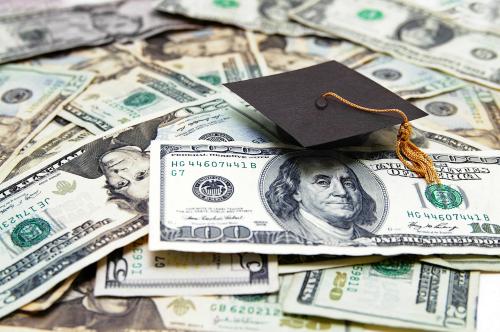The author has published a follow-up blog post, answering some questions raised by this report. You can read it here.
Some advocates have called to forgive student loans because student loans contribute to racial and socioeconomic wealth gaps. The usual measures of financial wealth, however, is a misleading indicator of the economic status of student loan borrowers. Medical school graduates typically owe six-figure student loans but that doesn’t mean they are poorer than high-school graduates who did not go to college. Wealth, properly measured, should include the value of educational investments students borrowed to make. Measured appropriately, student debt is concentrated among high-wealth households and loan forgiveness is regressive whether measured by income, educational attainment, or wealth. Across-the-board forgiveness is therefore a costly and ineffective way to reduce economic gaps by race or socioeconomic status. Only targeted policies can address the inequities caused by federal student lending programs.
- The persistence of the Black-white wealth gap is disturbing and deserves addressing. Across-the-board forgiveness of student loan debt is not a good way to address that problem. There are better, more effective, and more progressive ways to reduce racial wealth gaps.
- Whether measured by income or wealth, student loan borrowers are better off than other Americans, and widespread loan forgiveness is regressive. Some argue that loan forgiveness isn’t regressive when measured by financial wealth. But that’s because such measures exclude the very asset the person borrowed to buy—an education that increases lifetime earnings. That’s like assessing a homeowner’s wealth by counting their mortgage balance but not the value of their home.
- For many borrowers, the amount they are required to repay on their student loans is far below the amount they borrowed because of income-based repayment plans and existing forgiveness programs. We can and should make these programs work better.
- Accounting correctly for both human capital and effect of subsidies in student lending plans, almost a third of all student debt is owed by the wealthiest 20 percent of households and only 8 percent by the bottom 20 percent. Across-the-board student loan forgiveness is regressive measured by income, family affluence, educational attainment—and also wealth.

- Racial gaps in lifetime wealth are even larger when measured including the market value of educational attainment. But the key causes of that gap, as it relates to postsecondary education, are that Black Americans are much less like to have the opportunity to go to college in the first place, to attend a high-quality, low-cost college, to complete a degree, and to pursue a graduate or professional degree than their white peers. And Black graduates are rewarded less in the labor market for the degrees they complete. In part because of all this, Black borrowers struggle more repaying their student loans. But the contribution of student loans to the gaps in wealth and income is small, and the effects of loan forgiveness policies on economic gaps is surprisingly unclear.
- The best way to use federal postsecondary educational systems to close racial and socioeconomic gaps in income and wealth is through means-tested grant and loan aid that promote access and completion at high-quality educational institutions; rigorous oversight of institutions that participate in federal programs; progressive, well-designed and well-administered income-based repayment plans that insulate borrowers whose education doesn’t pay off, and targeted relief to borrowers who can clearly demonstrate that their loans impose significant economic hardship.
- Legislators should first decide how much taxpayers should pay of the tuition and living expenses of future students—a process that, in the name of fairness and efficacy, would no doubt choose to treat undergraduate, graduate, and professional degree students differently, base aid on need, and cap subsidies for high-cost programs—and use that as a template to provide retroactive relief to existing borrowers who missed out on those benefits while asking others to repay their loans.
The Brookings Institution is financed through the support of a diverse array of foundations, corporations, governments, individuals, as well as an endowment. A list of donors can be found in our annual reports published online here. The findings, interpretations, and conclusions in this report are solely those of its author(s) and are not influenced by any donation.
The Brookings Institution is committed to quality, independence, and impact.
We are supported by a diverse array of funders. In line with our values and policies, each Brookings publication represents the sole views of its author(s).







